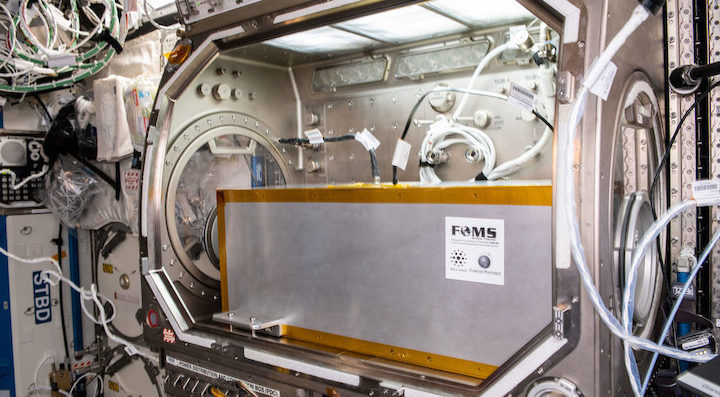9.11.2019

SAN FRANCISCO – Fiber Optic Manufacturing in Space (FOMS) Inc. presented the results Nov. 7 of its successful campaign to produce optical fiber on the International Space Station.
FOMS “successfully completed the calibration of the manufacturing hardware and demonstrated the first optical fiber manufacturing on orbit,” FOMS Principal Investigator Dmitry Starodubov announced at the 6th Workshop on Specialty Optical Fiber and Their Applications in Charleston, South Carolina. “The microgravity fiber demonstrated better uniformity than the fiber produced on the ground. This unique achievement is providing the basis for government and commercial utilization of our revolutionary space manufacturing platform.”
Entrepreneurs and investors have long pointed to optical fiber production as a killer app for in-orbit manufacturing, but the work is challenging. In addition to San Diego-based FOMS, Made In Space of Mountain View, California, and Physical Optics Corporation of Torrance, California, are working to produce high quality ZBLAN optical fiber on the space station with the support of the ISS National Laboratory, formerly known as the Center for the Advancement of Science in Space.
To produce optical fiber in orbit, FOMS created a suitcase size platform called Space Facility for Orbital Remote Manufacturing or SpaceFORM. FOMS sent two SpaceFORMs to ISS on a Northrop Grumman Cygnus cargo resupply flight in April. Astronauts helped install the platforms. The experiments were then monitored and controlled remotely by FOMS from Marshall Space Flight Center in Huntsville, Alabama.
The experiment was returned by a SpaceX Dragon in June. NASA accepted delivery of the first optical fiber produced on orbit by FOMS on August 26.
“Dmitry Starodubov and FOMS Inc. have developed and validated for use in microgravity a Space Facility for Orbital Remote Manufacturing, or SpaceFORM, to produce high-value, high-quality optical fibers,” Michael Roberts, interim chief scientist for the ISS National Laboratory, said by email. “The SpaceFORM platform supports the manufacture of fluoride-based optical fiber in space by exploiting a unique property of microgravity that results in significant improvement in the glass composition properties of these optical fibers, a discovery originally reported by NASA scientists. With significantly fewer imperfections, fluoride-based optical fibers manufactured in microgravity may perform up to 100 times more efficiently for data transmission on the ground than silica-based optical fibers.”
Silica-based optical fibers “are the backbone of our current multi-trillion-dollar global telecommunications system,” Lynn Harper, who leads Integrative Studies for NASA’s Emerging Commercial Space Office and for the NASA Ames Space Portal, said by email. “The less loss of signal, the more accurate the information and the farther you can send the signal without using a repeater or other connector.”
Still, more work needs to be done to prove that high-quality ZBLAN or other optical fibers can be produced consistently in orbit. If a company “can prove superior quality multiple times, it would provide confidence that the company had sufficient understanding of the art and control of the end-to-end manufacturing process to take it to larger scale production or unique formulations not possible on Earth,” Harper added.
FOMS first reported successful production of ZBLAN in orbit Aug. 1 at the ISS Research and Development conference in Atlanta, where the company received an award for its work.
Quelle: SN
